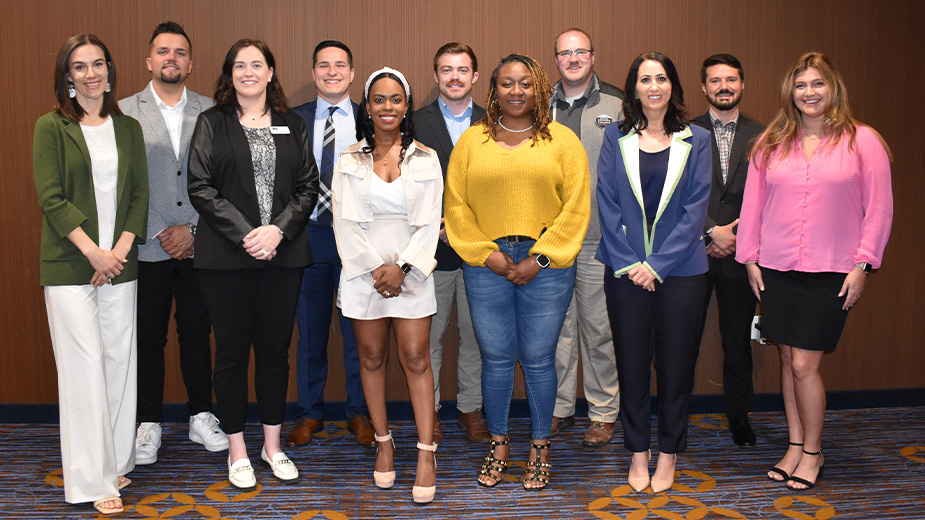Roundtable Panelists Examine Business Technology
CANFIELD, Ohio – What is the future of artificial intelligence? How has technology impacted small business? How prepared are small businesses for the dynamic changes in technology in the near-term, and how can they adapt?
These were just some of the questions that tech specialists from the Mahoning Valley tackled as part of The Business Journal’s Technology Roundtable held Feb. 7 at the Courtyard Marriott in Canfield.
The topics were addressed by Steve Cross of iSynergy, a digital marketing agency; Tim Petrey, partner at HD Davis CPAs and White Glove Payroll; Robert Merva, president of Avrem Technologies, an information technology service provider; Jim Rosenberg of NEO3, a provider of enterprise resource planning, or ERP, software; Dave Galioto of ECMSI, a managed service and IT service provider; Chris Wheatley of Peak I.T. and Valley Office Solutions, an IT service provider; and Ralph Zerbonia of Universe Central, a software developer.
From improving business systems to a future dominated by artificial intelligence, the tech world is accelerating at a rapid clip, the specialists said.
Artificial intelligence, or AI, is fast becoming a presence, said Universal Central’s Zerbonia, whose firm helps design AI systems. He said the concept of AI is essentially training computers on past information so they can formulate a response or action, he said. “When you ask it a question, it’s going to look at all the things it’s seen and give you an answer based on that.”
Captcha, the series of images – traffic lights, bicycles or vehicles, for example – or letter combinations that web users must identify before proceeding with their task, are not just for security purposes, Zerbonia said. “Their real business is to provide machine learning data for artificial intelligence,” he said.
He cites software for self-driving vehicles as an example. “You show a machine 600,000 red lights from all different perspectives, it has the ability to recognize it because it’s seen 600,000 of them. That’s how it works.”
NEO3’s Rosenberg said AI is transforming ERP software from “decision support systems to decision-making systems.”
Rosenberg said software traditionally provided data to the user so the client could make a decision based on that information. “Now we’re skipping that part and saying, ‘Here’s the data. Here’s the decision. Done,’” he said.
From purchase orders to supply-chain management issues, computers are making decisions for the client based on information learned by the system, he said. “The road is not smooth. There are rocks in the road, but that’s where it’s headed.”
Yet in the Mahoning Valley, the average business has been slow to make major investments in new technology, roundtable panelists said. On a national average, businesses spend approximately 7% of their revenue on IT. In this region, it hovers around 2%.
“A lot of it has to do with the history of the area,” said Peak I.T.’s Wheatley, noting the region’s heavy reliance on manufacturing and retail, two of the segments that traditionally spend the least on IT.
As such, smaller businesses in the Valley have a tendency to push IT to the bottom of their budget stack, making it a difficult sell to those who are conscious of expenses or are unfamiliar with the capabilities of upgrading their technology systems, he said.
“We have clients in 21 states,” Avrem’s Merva added. “We don’t get some of the pushback in some of the other states that we do in northeastern Ohio and western Pennsylvania.”
One of his clients, he found, was still using a dial-up internet connection.
However, Wheatley noted some companies are beginning to pay closer attention because of high-profile cybersecurity breaches.
“They’re looking for cybersecurity insurance, and insurance providers are demanding they make changes to their networks,” he said. “It’s given us an avenue into making improvements at some companies that I don’t think would have been ready for it otherwise.”
To place this into context, Merva said three to five years ago the average cybersecurity insurance application numbered one or two pages. “The last insurance application I worked on a couple weeks ago with a client was 37 pages. Same coverage, same company, same insurance carrier.”
Moreover, the pace of tech development has accelerated in the span of just a few years, roundtable panelists agreed.
“Over the course of the last two years, we’ve had roughly two decades of evolution in technology,” Petrey said. “We have been forced to adapt to something that none of us expected, but the benefit of that is that technology has grown so fast.”
Technology and automation has made it easier for his company and its clients to accomplish tasks such as bookkeeping, data collection for business analytics and other functions, he said. This acceleration of tech services allows smaller companies to compete at a much higher level.
“It’s been a lot fun to see that evolution over the last three years,” Petrey said. “We’ve seen things like QuickBooks online grow to a whole different monster, platforms like Fathom – all the different things that help small businesses compete with very large businesses.”
Cloud computing, in which tech applications and functions are stored outside a computer hard drive and can be accessed through multiple devices, has also proven invaluable to companies in the face of an emergency.
Nothing exposed this more than the COVID-19 pandemic, said iSynergy’s Cross.
The pivot to remote work for the digital marketing company during the pandemic proved relatively easy, Cross noted. “People came into the office, grabbed their stuff and went home,” he said.
“We had our internal communications already set up, our PM (project management) tools set up. We had all of our marketing platforms online. We had Gmail, so we already had Google Meet set up,” Cross said. “We were ready to go.”
ECMSI’s Galioto said that many of his company’s clients had disaster plans at the ready in case of a catastrophe, so the transition to remote work during the pandemic was also comparatively smooth.
The challenge was to secure home networks, which could be vulnerable to a security breach, Galioto said.
“It’s easy to secure inside your firewall and inside your network, but how do you secure the end points that are not protected by you or managed by you?” he said. This requires implementing different filtering procedures in order to keep that network protected, he noted.
In some cases, the adoption of new tech systems has enabled firms to avert the effects of major disruptions, such as the recent train derailment in East Palestine. That disaster prompted a mass evacuation of nearby residents and shut down businesses.
Wheatley said one of his clients, a waste management business in East Palestine, was forced to evacuate but was able to keep business moving remotely.
“We made a couple changes to their phone system. They were using their laptops. They were already set up to get their email from anywhere,” Wheatley said. “It’s still a scary time for their business, but they were able to keep in communication with their customers and operate.”
Critical to advancing technology in the Valley’s business sector is to reassure companies that IT is not something to be feared, but instead welcomed, said iSynergy’s Cross.
“Don’t be afraid of it,” Cross said. “Embrace it. Learn it. Educate yourself.” Then, a company can evaluate how to best use this technology in order to retain a competitive edge.
HD Davis’ Petrey advised a good starting point is for companies to take a “tech inventory” of their IT tools, evaluating how they are used and their costs.
“If you sit down, write down every piece of technology that you’re using, the problem that it’s solving, and the costs associated with it, you’re going to be that much more prepared when it comes time to looking at other options,” he said.
The good news is that IT management companies have the expertise and capability to help clients achieve this, Avem’s Merva said. “Get the right people on board and leverage those people to help them.”
Ultimately, IT companies and software providers are in the business of “change management,” added NEO3’s Rosenberg.
“It’s incumbent upon us in the IT world to introduce these things to people and help them make their decisions based on the information we’ve accumulated over the years in the business,” Rosenberg said. “That’s what we need to do.”
Pictured at top: From left are Dave Galioto, Jim Rosenberg, Robert Merva and Tim Petrey.
Copyright 2024 The Business Journal, Youngstown, Ohio.




